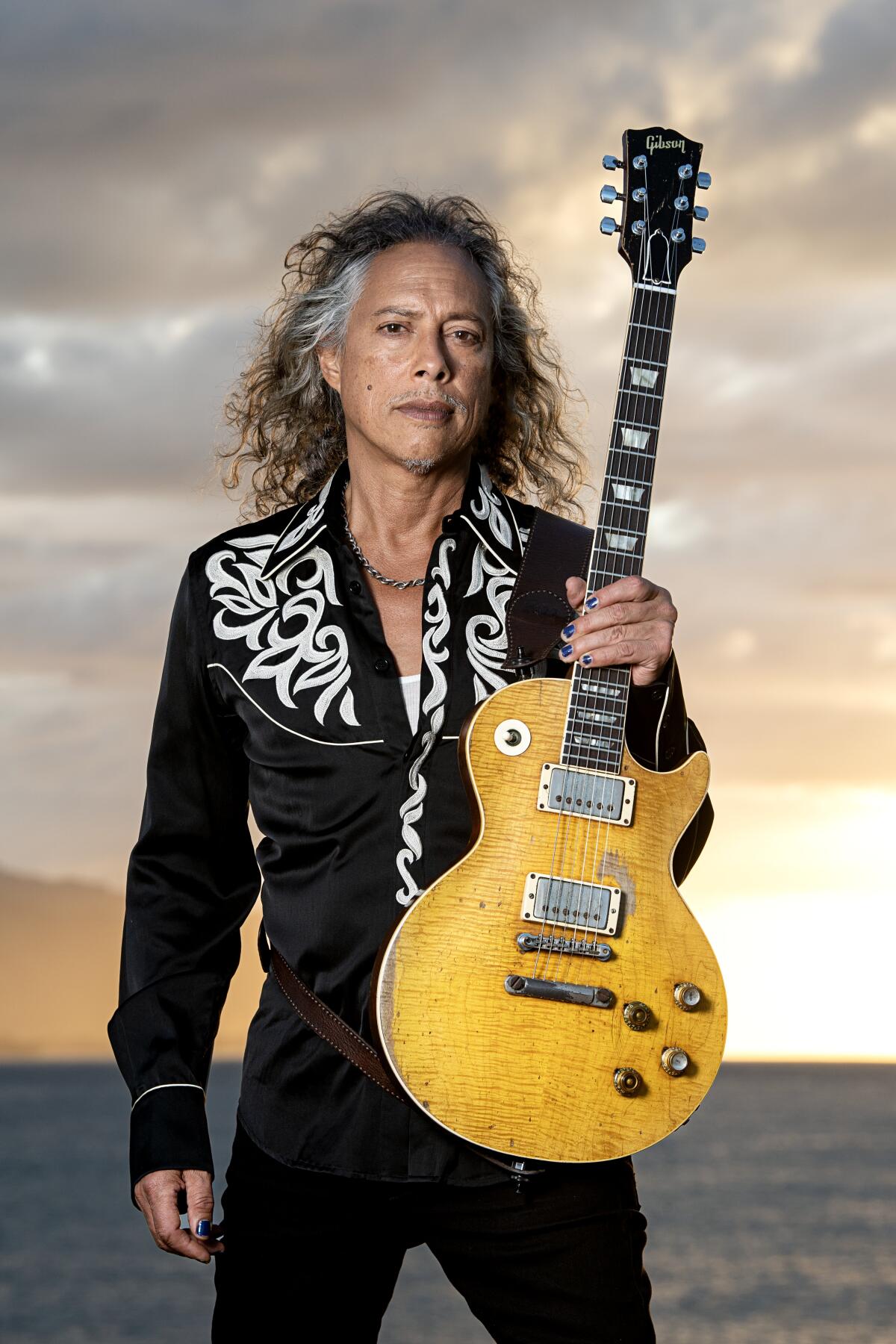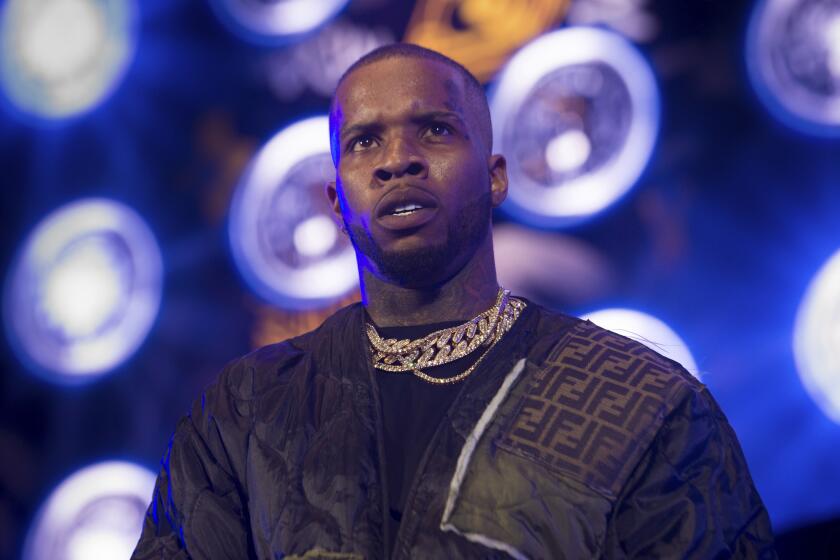New photo book by Metallica’s Kirk Hammett highlights his ‘holy grail’ of rare six-strings

- Share via
For Metallica’s Kirk Hammett, there is one electric guitar that stands above the rest in his arsenal for the metal band’s ongoing M72 world tour. He thinks of it as his Excalibur, he says.
It is a 1959 Gibson Les Paul once owned by the late Peter Green, founding guitarist of Fleetwood Mac, and a former member of John Mayall’s Bluesbreakers. It later passed from Green to Gary Moore, who played it on Hammett’s favorite Thin Lizzy album, “Black Rose.”
The golden instrument is now part of Hammett’s vast collection of vintage and custom-made guitars, and even in that company, the guitar nicknamed “Greeny” is special. The Metallica lead guitarist is often on YouTube searching for old videos of Green, Moore and others playing it live across the decades.
“That guitar’s been through so much, and it’s hurt so much and sang so much,” Hammett says. “I just gotta try and keep it going in my own personal way.”
The guitar now has a prominent place in a new book dedicated to the Metallica guitarist’s stockpile of instruments, “The Collection: Kirk Hammett,” a 400-page coffee-table book from Gibson Publishing. It includes interviews with the heavy metal player, histories of the guitars, with vivid photography by Ross Halfin.
The book isn’t a catalog of his entire collection, but goes deep on individual instruments. (The chapter devoted to “Greeny” is 40 pages alone.) Hammett says he doesn’t know how many guitars he owns, and he doesn’t really want to know.
Now on the road with Metallica in support of their “72 Seasons” album, Hammett plays several guitars a night, but his attention often remains on “Greeny.” It’s the one guitar he carries with him everywhere— to and from the shows, to the hotel room, onto the band’s plane.
“I carry it with me, so I’m directly responsible for anything that happens to it,” he says. “Where I’m sleeping, ‘Greeny’ is usually 10 feet away.”
He’s also made a point of handing the guitar to other players to try out. In the book are several portraits of guitar heroes posing with Greeny: Pete Townshend of the Who, David Gilmour of Pink Floyd and ZZ Top’s Billy Gibbons. Green’s former bandmate, drummer Mick Fleetwood, is also pictured cradling the guitar. So is Aerosmith singer Steven Tyler.
All were part of a 2020 tribute to the late Fleetwood Mac co-founder at the London Palladium, and during that night Hammett played the solo on Green’s “The Green Manalishi (With the Two Prong Crown),” unfurling an elegant flow of blues melody very different from Metallica’s angular roar. Afterward, Fleetwood stood up and yelled, “Nailed it!”

Hammett once handed the guitar to Jack White, who then played it for several songs during a concert. Melvins guitarist Buzz Osborne has also held it, and said in a podcast last year, “There’s so many other stupid things you could spend your money on, but that ... is almost like finding the Holy Grail or the Arc of the Covenant.”
The new book is available on the Metallica website, at Gibson.com, and at stops on Hammett’s book tour, with upcoming appearances in Columbus, Ohio; Philadelphia; Tampa, Fla.; and Denver. It’s part of another busy period for his band, with a remastered box set of 1996’s “Load” album coming in June. Metallica is also set to join Black Sabbath for its final concert on July 5 in Birmingham, England.
In the book, one thing that is noticeable pretty quickly is that these are not museum pieces protected behind glass. They show the wear and tear of use in the studio and onstage, in many cases from generations of different players. Many are scuffed and scratched, chipped and stained. For Hammett, that’s how it should be.
“I can’t help but use them. I know people have to put on white gloves while you’re handling a [collectible] guitar: ‘Take off your belt, take off your leather jacket, no zippers.’ I’m like, ‘Huh?’” Hammett says, laughing.
“Literally, I take that guitar out of the case, I plug it in, I start playing it. I’m not precious with my guitars,” he adds, noting that an accidental nick to the surface of a pristine vintage instrument could instantly cost it thousands of dollars in value. “I have some serious issues with that kind of thinking. I just want to play the guitars, and if there’s a scratch or a bump, so what? I don’t go in for mint instruments because mint instruments don’t sound good. They have no soul, bro.”
Hammett was approached about doing a book by the Gibson guitar company, which had begun a publishing project, starting with a volume documenting the guitars of Slash. The author of the text for both books is Chris Vinnicombe, editor in chief at Gibson. For “Greeny” and other guitars, Hammett “sees himself as the custodian” of these rare instruments, he says.
“He loves the rarity and the romance behind them,” says Vinnicombe. “I don’t think he’s just trying to compile a kind of box-ticking collection of vintage classics just as an ownership project. He loves the chase and he loves the romance and the stories.”

Hammett had already published a book from his collection of horror movie posters, 2017’s “It’s Alive.” His devotion to collecting horror and sci-fi memorabilia and movie props is second only to guitars, and those interests sometimes overlap. He has several custom-made ESP guitars with horror themes, including the classic 1930s films “Bride of Frankenstein,” “The Mummy” and “White Zombie.” And now that he’s just purchased a Bela Lugosi cape used in 1948’s “Abbott and Costello Meet Frankenstein,” he’s planning on a guitar with that theme as well.
Next will be a book of his vintage surfboard collection, he predicts. One of those boards dates back to 1970, and is decorated with drawings of ocean waves and flying saucers. Hammett was told it was made for Jimi Hendrix while the guitar icon was in Maui, though he can’t confirm it. “It’s still a cool story anyway,” he says with a laugh.
In “The Collection,” the metal guitarist goes deep into the history and sound of individual guitars. Sometimes the look of a guitar is as essential as the sound.
“The first time I saw an electric guitar as a teenager, it was love at first sight. I saw it from across the high school hallway,” Hammett recalls of his first in-person sighting of a guitar at about age 14. Some of the older kids at De Anza High School in Richmond, Calif., were holding a Fender Stratocaster, glowing with an orange sunburst design. “It looked like a hot rod to me. It looked like a rocket. It looked like you could get on it and just take off somewhere else.
“Guitars for me have always had a really uplifting quality to them just by the way they look. For me, guitars look so incredibly cool. Everything about the guitars — the wood, the shiny metal, the strings, the sound — I love it. For me, it’s the greatest American invention there ever was.”
He grew up in a Bay Area household where the soundtrack tended to be a mix of jazz and opera, salsa and show tunes. His older brother sometimes brought home a record by the Beatles or Hendrix. And Hammett was soon playing air guitar with his brother’s tennis racket.
Hammett finally got his first electric guitar, a low-budget Montgomery Ward model he traded in exchange for $10 and a Kiss album. He was inspired by the rock music of his adolescence: Kiss, Aerosmith, Led Zeppelin and UFO. “That’s what was fueling all of it,” he says, “and a total dysfunctional childhood, and not knowing where to turn, not having any safe places to go, especially in San Francisco growing up. Music was an emotional, mental relief from all the crap that was going on around me as a kid.”
In high school, he started a rock trio called Mesh, but Hammett and his friends could barely play. “Some of the funniest stories you ever hear are musicians when they first started out and how crappy they are and how bad their band names are,” he says with a laugh.
As his skills evolved, he formed a new band called Exodus, which would ultimately be an important player in the first wave of thrash metal in San Francisco. He eventually moved up to a Fender Stratocaster copy guitar. And as things got more serious, he saved money from his job at Burger King to buy a Gibson Flying V in 1979, a choice of weapon inspired by the example of guitarist Michael Schenker of UFO. The Scorpions and Accept also carried Flying V’s. Paul Stanley from Kiss played one.
“That was a game changer for me,” he says now of getting his first significant guitar, and the model remains important to him. He’s shown holding a Flying V on the front and back covers of his new book.

Hammett joined Metallica in 1983, just before the band recorded its debut album, “Kill ’Em All.” In hindsight, that was a wise and obvious career move, but at the time Exodus was as much of a viable young band with a following in the Bay Area. Even so, Exodus was at an impasse when Hammett got an unexpected call from Metallica. He packed up and drove east in time for the recording sessions in Rochester, N.Y.
“I can’t remember why we went on hiatus, but during that hiatus a kind of split happened,” Hammett recalls of his final days with Exodus. “I don’t know how else to put it, but we started doing different drugs. All of a sudden, I felt alienated from the rest of the guys.”
He points out that last month marked the 42nd anniversary of his first rehearsals as a member of Metallica. “When I first saw Metallica, I thought to myself, ‘Wow, these guys are great, but they’d be so much better with me in the band,’” Hammett says of his first time seeing the band. “That was a very conscious thought while I was sitting in the back of the room watching them.”
Together, Metallica led a thrash metal movement that began as an underground sensation but turned out to be more lasting than a lot of the more commercial metal then coming off the Sunset Strip. Decades later, and now one of the most successful rock bands ever, Metallica celebrated that revolutionary history with a series of “Big 4” festivals in 2010 and 2011, as one of four leading forces in that original movement, alongside Slayer, Megadeth and Anthrax.
In “The Collection” is a group portrait of Hammett and Metallica frontman James Hetfield posing with other guitarists from that tour: Slayer’s Kerry King, Megadeth’s Dave Mustaine and Anthrax’s Scott Ian.
“We all heard the same sound in our heads. All us guitar players gravitated to those same new wave of British heavy metal bands — gravitated to that hyper-aggressive, energetic sound, because that’s what our personalities kind of demanded,” Hammett explains of their shared movement, which collided the dual influences of U.K. heavy metal and punk rock. “You have to be a little bit ornery, a little bit passive-aggressive, a little bit dysfunctional, a little predatory, to write and record and perform this music. So it was a lot of the right personality types and the right personality disorders, when it was needed.”
In 2023, Metallica released “72 Seasons,” the third in a trilogy of albums that reached back to a modern take on that original sound. As they play the new songs in stadiums around the world, alongside career milestones like “Enter Sandman” and “Master of Puppets,” Hammett has many guitars at his disposal. And “Greeny” is always there.
“None of us thought this would be the sound of the future for decades to come,” he says of the thrash movement. “We thought we were all just outliers, having our little group of friends playing the music that we wanted to play and doing it because it was fun. We had no idea what it would become.”
More to Read
The biggest entertainment stories
Get our big stories about Hollywood, film, television, music, arts, culture and more right in your inbox as soon as they publish.
You may occasionally receive promotional content from the Los Angeles Times.













